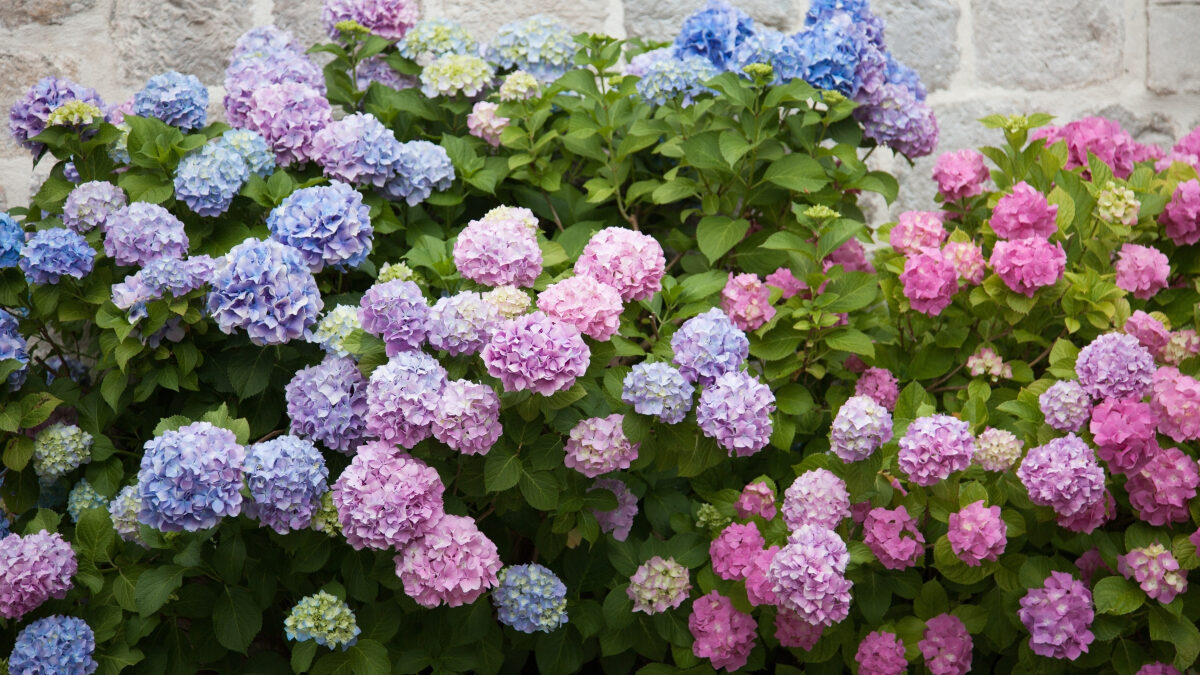Hydrangeas are very popular among many gardeners because of their distinctive blossoms. These massive midsummer flowers have been known to turn heads. Despite their visual appeal, hydrangeas can be a little bit tricky to grow, depending on the variety. Nevertheless, anyone can enjoy hydrangeas. The most important step is to have basic knowledge about the type of hydrangea when choosing a plant.
Bigleaf
Bigleaf hydrangeas are one of the most popular varieties of hydrangeas because of their large, colorful flowers. However, they are also the least hardy type and can often fail to bloom if they experience a difficult winter or are overpruned.
Here are some tips for caring for Bigleaf hydrangeas:
- Choose a location that receives partial to full shade.
- Plant in well-drained soil.
- Water regularly, especially during hot weather.
- Fertilize in spring and fall.
- Prune in late winter or early spring, just before new growth begins.
- Protect from frost in cold climates.
With proper care, bigleaf hydrangeas can be a beautiful addition to your garden.
Here are some additional tips for growing bigleaf hydrangeas:
- You can change the color of the flowers on bigleaf hydrangeas by adjusting the pH of the soil. Acidic soil will produce blue flowers, while alkaline soil will produce pink flowers.
- Bigleaf hydrangeas are susceptible to a number of pests and diseases, so it is important to inspect your plants regularly and treat any problems promptly.
- Bigleaf hydrangeas can be divided in the spring or fall to create new plants.
Smooth
Hydrangea arborescens, commonly known as smooth hydrangeas, is a cold-hardy type that is easy to grow. Native to the eastern United States, A. arborescens is a deciduous shrub that can be grown in full sun or partial shade.
The following are some additional details about smooth hydrangeas:
- They are a small to medium-sized shrub, typically growing 3-6 feet tall and wide.
- They have smooth, gray-brown bark and opposite, oval-shaped leaves that are 2-6 inches long.
- The flowers are white or pink and are borne in large, flat-topped clusters.
- They bloom in late spring or early summer and the flowers can last for several weeks.
- Smooth hydrangeas are relatively low-maintenance plants and are drought-tolerant.
- They are deer-resistant and can be grown in a variety of soils.
- They are a popular choice for landscaping and are often used as foundation plants, hedges, or specimen plants.
Little Lamb
Little Lamb hydrangeas have a delicate white bloom packed into fluffy clusters. This mass of flowers resembles baby lambs in a field prancing across the foliage. Like Quick Fire and Limelight, this variety of hydrangeas does not require winter protection. During the summer, children, in particular, will have fun picking little lamb hydrangeas.
Here are some additional details about Little Lamb hydrangeas:
- They are a compact shrub, typically growing 4-6 feet tall and wide.
- They have dark green leaves and produce large, conical clusters of white flowers in late summer.
- The flowers can last for several weeks and are often used in cut flower arrangements.
- Little Lamb hydrangeas are relatively easy to grow and are deer-resistant.
- They are a popular choice for landscaping and are often used as foundation plants, hedges, or specimen plants.
Panicle
Panicle hydrangeas (Hydrangea paniculata) have a higher success rate for most gardeners. These plants are versatile and resilient, thriving in most situations. They produce large, fluffy summer blooms and can be pruned at any time. Panicle hydrangeas bloom early, even after severe pruning, late frost, and hard winters. They are also adaptable to a variety of lighting conditions and soil types. Another advantage is that the color of the blooms is not affected by soil pH, unlike bigleaf hydrangeas.
Here are some additional details about panicle hydrangeas:
- They are a large shrub, typically growing 6-8 feet tall and wide.
- They have dark green leaves and produce large, conical clusters of white, pink, or red flowers in late summer.
- The flowers can last for several weeks and are often used in cut flower arrangements.
- Panicle hydrangeas are relatively easy to grow and are deer-resistant.
- They are a popular choice for landscaping and are often used as foundation plants, hedges, or specimen plants.
QuickFire
While many panicle hydrangeas have white blooms, newer varieties have a wider range of colors. One such variety is QuickFire, which blooms early in the season. Because of its early blooming, this variety reaches full bloom before other types have just started the process. The blooms will start off with a white appearance and eventually turn a deep pink by mid-summer.
QuickFire is a popular choice for landscaping because it is versatile and easy to care for. It is deer-resistant and can be grown in a variety of soils. It is also drought-tolerant, making it a good choice for areas with hot, dry summers.
If you are looking for a beautiful and low-maintenance shrub, QuickFire is a great option. It is sure to add color and interest to your garden.
Limelight
Another new variety is Limelight, a large, soft-green flower that turns pink in the fall. Limelight can be used as a low-maintenance hedge, or as an addition to an existing shrub border. It can grow 6 to 8 feet in height and can tolerate both partial shade and sun. Limelight retains some green color when dried, making them an excellent choice for a bouquet.
Here are some additional details about Limelight hydrangeas:
- They are a large shrub, typically growing 6-8 feet tall and wide.
- They have dark green leaves and produce large, conical clusters of soft-green flowers in late summer. The flowers turn pink in the fall.
- The flowers can last for several weeks and are often used in cut flower arrangements.
- Limelight hydrangeas are relatively easy to grow and are deer-resistant.
- They are a popular choice for landscaping and are often used as foundation plants, hedges, or specimen plants.
Conclusion:

With a little bit of knowledge, anyone can enjoy the beauty of hydrangeas in their garden. There are many different varieties of hydrangeas to choose from, so there is sure to be one that is perfect for your needs. With proper care, hydrangeas will thrive and provide you with years of enjoyment.
Here are some additional tips for growing hydrangeas:
- Choose a variety that is suited to your climate and growing conditions.
- Plant hydrangeas in well-drained soil.
- Water hydrangeas regularly, especially during hot weather.
- Fertilize hydrangeas in spring and fall.
- Prune hydrangeas in late winter or early spring, just before new growth begins.
- Protect hydrangeas from frost in cold climates.
With proper care, hydrangeas can be a beautiful addition to your garden.

